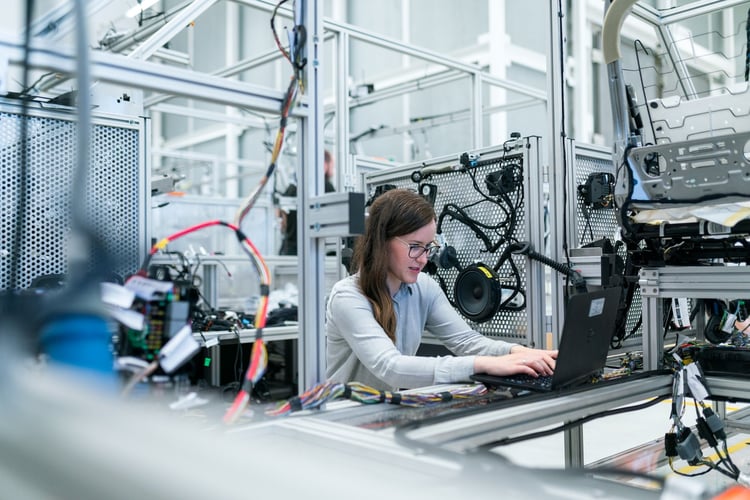
Sustainable manufacturing is a forward-thinking approach to business that balances economic growth with the well-being of the environment, employees, customers, and communities impacted by manufacturing activities. Sustainable practices prioritize energy efficiency, waste reduction, material reuse, and employee satisfaction. This way, they reduce waste, improve workers' health, and drive productivity and long-term success. For this reason, today, we will go in-depth on how to increase productivity with sustainable manufacturing practices.
1. Implementing Renewable Energy Sources
By incorporating renewable energy sources, manufacturers can prioritize sustainability and reduce their carbon footprint. Renewable energy sources like solar and wind power are environmentally friendly. They do not deplete natural resources or contribute to climate change. By relying on renewable energy instead of non-renewable resources like fossil fuels, manufacturers can reduce their environmental impact, reduce pollutants, and support a cleaner planet. Additionally, using renewable energy sources can support local job growth and reduce the effects of off-shoring and outsourcing. Manufacturers can reap environmental and financial benefits by investing in renewable energy technologies. It can also allow them to follow manufacturing safety guidelines much more quickly.
2. Minimizing Waste and Maximizing Resource Use
The circular economy is a sustainable economic model that prioritizes the reduction of waste and efficient use of resources. Unlike the traditional linear economy, which relies on finite, non-renewable resources, a circular economy seeks to close the loop on material use by designing products and processes for reusability, repair, refurbishment, and recycling. Circular manufacturing practices include:
- Designing products for disassembly (or "upcycling") so they can be quickly taken apart for reuse or recycling when they're no longer needed;
- Using renewable resources when possible instead of mining metals from the earth;
- Reusing components rather than buying new ones if possible;
- Recycling materials into new products rather than throwing them away after one use (for example, using steel scrap from old cars);
The circular economy is not just limited to manufacturing practices. It also encompasses the way we store and manage our possessions. According to experts at helixmove.com, the principles of a circular economy can be applied to storing products and materials, promoting the efficient use of resources, and reducing waste.
3. Eliminating Waste From Raw Materials To The End Product
Eliminating waste from raw materials to the end product is a crucial aspect of sustainable manufacturing practices. Businesses cannot only minimize their environmental impact by minimizing the amount of waste produced throughout the entire production process, from sourcing raw materials to the creation of the final product. However, they can also reap the benefits of improved efficiency and cost savings. This goal is achievable through the implementation of various strategies. One such strategy is using lean manufacturing techniques, implementing waste reduction programs, and optimizing supply chain management processes.
These efforts can lead to a significant reduction in the amount of waste generated, an increase in the use of recycled materials, and a decrease in the amount of energy and resources required to produce products. In addition to these strategies, businesses can recycle waste materials to create new products or generate biofuel. That not only reduces the number of raw materials required for manufacturing but also has the potential to increase profits by reducing costs. Finally, companies can reduce their water usage by investing in water-efficient equipment and recycling wastewater instead of disposing it in rivers or lakes.
4. Good Employee Relationships, Including Work-life Balance
Sustainable manufacturing practices don't only benefit the environment and workers. They also positively impact the business. A workplace where employees are happy and have a good work-life balance is more productive. That often leads to more profit. According to a Gallup study, in 2022, only 20% of employees were engaged in their work, a decrease from 26% in 2021. That means that 80% of workers were either not engaged or actively disengaged from their jobs, costing employers an estimated $500 billion annually. Work-life balance can be challenging for those working long hours in a demanding job without much flexibility. That can contribute to increased stress levels, negatively impacting personal and family life and potentially leading to health issues such as obesity and heart disease. However, companies with solid cultures built on trust between management and employees tend to have more satisfied staff who feel valued.
5. Better Worker Health And Safety
Sustainable manufacturing practices actively reduce the risk of employee injuries and illnesses. That is accomplished by actively reducing the number of chemicals used in manufacturing processes, actively increasing ventilation, and actively using safer equipment, such as machinery with lower vibration levels. Furthermore, sustainable manufacturing practices actively encourage employees to take more breaks during their shifts, improving their overall well-being and productivity.
Active morale among staff members actively helps increase efficiency at work because they feel appreciated by management, who have actively implemented these changes to ensure the safety of all workers, both on-site during work hours and off-site during non-work hours (e.g., lunch breaks).
Sustainable Manufacturing Is The Future Of Large-scale Manufacturing
It uses less energy and resources, is more profitable, and is better for the environment. A sustainable company will have a competitive advantage over other companies that don't employ sustainable practices because they can simultaneously reduce costs while increasing profits and productivity. Sustainable manufacturing is not only the future of business. It's a necessity. The world faces an environmental crisis that will only worsen if we don't act now. Every company needs to be sustainable; otherwise, they won't survive long-term.
Conclusion
Sustainable manufacturing is the future of large-scale manufacturing. It offers many benefits for companies and consumers, including increased productivity and improved worker health. By adopting these practices, you can ensure that your company can keep up with the demands of today's consumers while also staying ahead of the competition in tomorrow's marketplace. Therefore, now that you know how to increase productivity with sustainable manufacturing practices, nothing is preventing you from implementing them today.







